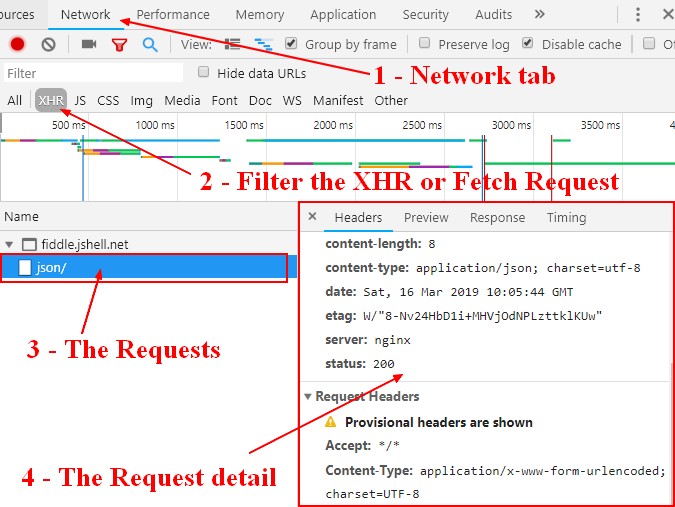About
The fetch function is part of the web api function and is a AJAX call. It's one of the possibilities to fetch a resource.
This is a new interface with more control than the XMLHttpRequest (XHR)
The fetch function returns a promise as response.
The Fetch Standard defines the fetch() JavaScript API
It exposes most of the networking functionality at a low level of abstraction.
Syntax
The response of a fetch() request is a Stream object, which means that when we call the json() method, a Promise is returned since the reading of the stream will happen asynchronously.
Then
fetch(url, {
body: JSON.stringify(data), // must match 'Content-Type' header
cache: 'no-cache', // *default, no-cache, reload, force-cache, only-if-cached
credentials: 'same-origin', // include, *omit
headers: {
'user-agent': 'Mozilla/4.0 MDN Example',
'content-type': 'application/json'
},
method: 'POST', // *GET, PUT, DELETE, etc.
mode: 'cors', // no-cors, *same-origin
redirect: 'follow', // *manual, error
referrer: 'no-referrer', // *client
credentials: 'same-origin'
})
.then(
function(response) {
if (response.status !== 200) {
console.log('Bad request, status Code is: ' + response.status);
return;
}
// Response properties
console.log(response.headers.get('Content-Type'));
console.log(response.headers.get('Date'));
console.log(response.status);
console.log(response.statusText);
console.log(response.type); // "basic", "cors" or "opaque"
console.log(response.url);
// Parses response data to JSON
// * response.json()
// * response.text()
// are promise, you need to pass them to a callback to get the value
response.json().then(function(data) {
console.log(data);
});
}
)
.catch(function(err) {
console.log('Fetch Error', err);
}
Async / Await
async await syntax
with the URL api
let url = new URL('https://hostname/endpoint');
url.searchParams.set("key", "value: );
let response = await fetch(url.toString(), {method: "GET"});
if (response.status !== 200) {
console.log('Bad request, status Code is: ' + response.status);
return {};
}
// Parses response data:
// * response.json() to get an object
// * response.text() to get a text
let jsonObject = response.json();
Request
The request is specified in the first block of the fetch statement and has properties.
Credentials
Credentials are HTTP cookies, TLS client certificates, and authentication entries (for HTTP authentication).
Values:
- same-origin: the same-origin cookie are send
- include: allow sending cookies on cross-origin request (to other domains), via CORS requests
Mode
Mode possible values:
- no-cors (Default) (ie no-cors) (discouraged - unsafe): Restricts requests to using:
- CORS-safelisted method (GET, HEAD, or POST)
Upon success, fetch will return an opaque filtered response. ie a no-cors mode will give you an opaque response, which doesn't seem to return data in the body. See Opaque Response
- same-origin: Used to ensure requests are made to same-origin URLs
- cors: Makes the request a CORS request.
- navigate: This is a special mode used only when navigating between documents.
- websocket: This is a special mode used only when establishing a WebSocket connection.
For an HTML element that fetch resources (such as javascript, stylesheet), you can set the mode with the crossorigin attribute
Management
Polyfill
See
In the Browser devtool, you can see them.
Example with Chrome.
Example
Get
With get, you need to use the url web api object to construct your URL.
response.text() return a promise, you need to resolve it
var url = new URL("/doc/api/weather",window.parent.location.href);
url.searchParams.set("country", "Netherland");
fetch(url.toString(), {
method: 'GET', // *GET, PUT, DELETE, etc.
})
.then(function(response) {
console.log(response.status);
console.log(response.statusText);
console.log(response.type);
console.log(response.url);
// Response text is a promise, you need to pass it to a callback to resolve it
response.text().then(function(data) {
console.log(data);
});
})
Post
A post that sends form-urlencoded data.
var data = { name: "Foo", age: 46, city: "Oegstgeest" }
var formData = new URLSearchParams();
formData.append('json', JSON.stringify(data));
fetch('aURL', {
body: formData,
cache: 'no-cache',
credentials: 'same-origin',
headers: {
'Content-Type': 'application/x-www-form-urlencoded;charset=UTF-8'
},
method: 'POST',
mode: 'no-cors',
redirect: 'follow',
credentials: 'same-origin'
})
.then(response => console.log(response))
or
fetch(url, {
method: 'post',
headers: {
"Content-type": "application/x-www-form-urlencoded; charset=UTF-8"
},
body: 'foo=bar&lorem=ipsum'
})
.then(response => response.json())
.then(function (data) {
console.log('Request succeeded with JSON response', data);
})
.catch(function (error) {
console.log('Request failed', error);
});
More
Wrapper Library
isomorphic-unfetch
- https://github.com/developit/unfetch - unfetch is a wrapper around the fetch api that works in the server and client side.
npm install --save isomorphic-unfetch
